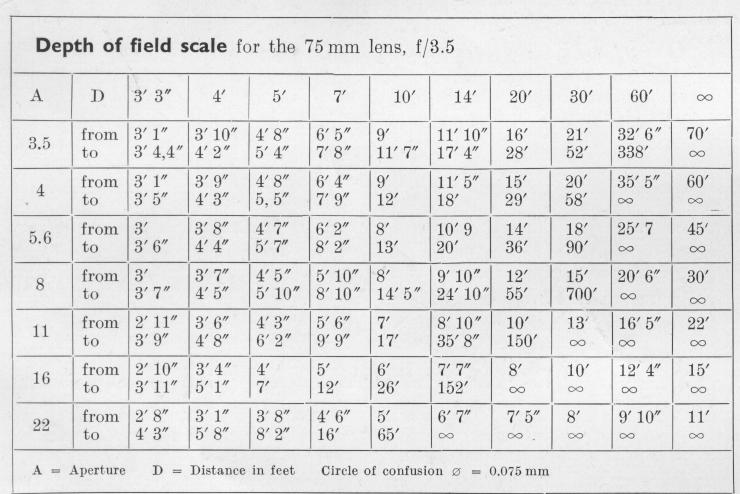and historical purposes, all rights reserved.
This page is copyright© by
This page may not be sold or distributed without
the expressed permission of the producer.
I have no connection with any camera company.
WELTAFLEX
posted 2-19-'04
This camera manual library is for reference
and
historical purposes, all rights reserved.
This page is copyright© by ![]() ,
M. Butkus, NJ.
,
M. Butkus, NJ.
This page may not be sold or distributed without
the expressed
permission of the producer.
I have no connection with any camera company.
On-line camera manual library
If you find this manual
useful, Back to
main camera manual page
Weltaflex PDF manual
Weltaflex 6X6 Bedienungsanleitung
Weltaflex 6X6 Bedienungsanleitung
WELTAFLEX 6X6 The Weltaflex is a twin-lens mirror reflex camera. For NEWER version that do not have red window. There is a small lever cam at
the bottom that MUST be against the bottom "automating" pin when you close the
back. That pin sets the "auto-number" counter on the side of the newer version.
Fire shutter, press in pin with hand and roll on the roll from the bottom to top
spool stopping the arrows at the bottom rollers. Make sure the arm and pin are
touching and that will set the auto framing. wind the shutter, then wind to the
first frame. 5. Film transport By pushing up the light hood knob (14) on the light hood frame (15) causes
the light hood (18) to jump into working position. Focusing is performed by means of the focusing knob (9) on the left side of
the camera. The eyepiece of the sports finder is provided with parallax compensation -
adjustment by means of the little knob (16) on the rear flap. Before closing the
light hood, do not forget first to fold back the cover (4) with the factory sign.
This is done by pressure on the rear flap from the inside, whereby the little
cover jumps Time exposures 6. Setting the diaphragm 9. The flash contact In order to obtain shutter synchronization with powder flashes for instant
exposures, you will need an electric kindling device. Advice regarding shutter
speeds is given by the manufacturers. with suitable For the general use of powder flashes without shutter synchronization, the
shutter has to be set at "B" and released by means of a special cable release
which is fastened automatically when the shutter opens and is unlocked on second
pressure. 1. Exposures without flash: M or X setting. Self-timer exposures with flash are subject to the same rules as the X
setting (see chart).
how about a donation of $3 to:
M. Butkus, 29 Lake Ave.,
High Bridge, NJ 08829-1701
and send your
e-mail address
so I can thank you.
Most other places would charge
you $7.50 for a electronic copy
or $18.00 for a hard to read Xerox copy.
buy new manuals,
and pay their shipping costs.
It'll make you feel better, won't
it ?
If you use Pay Pal, use the link below.
Use the above address for a
check, M.O. or cash.
English version
Word version


1. Taking lens
2. Finder lens
3. Cable release
connection
4. Sports finder cover
5. Latch
6. Eyelets for
carrying strap
7. Spool knob
8. Depth-of-field scale

9. Focusing knob
10. Flash contact
11. Spool
knob
12. Pan-protection cover
13. Latch knob
14. Light hood
knob
15. Light hood frame

16. Knob
17. Focusing magnifier
18. Light hood
19. Film transport knob
20. Body shutter release
21. Pan-protection
knob
22. Brake spring
23. Hinge pin
Special feature of
this camera is the use of a separate lens, with the same aperture as the taking
lens, for focusing the image on the ground glass. Continual viewing and
supervising of the subject is thus possible.
Whether amateur or
professional, you will always find the Weltaflex a valuable asset.
I f you
want to derive genuine pleasure from your camera, first study the Instructions
for Use thoroughly and practice using the camera without a film in it.
The
Weltaflex takes the usual 2 1/4;< 2 1/4"(6 X 6 cm-.) - B II - 8 film, and
divides this film into 12 exposures.
A: Inserting and
changing the film
-
It will stop automatically (if everything is working right !
) After you fire.. set shutter, wind.
Rotate film
transport knob (19) until, after the caution sign, the number "1" appears in the
pan-protection window.
6. Closing the film window
Push the
pan-protection knob (21) downward, whereupon the light circle appears in the
pan-proof window, and the camera is ready for picture-taking.
Performances
4 to 6 are repeated after every exposure, i.e. 12 times with each film.
7. Removing the film
You have already been told in
paragraph 1 how to open the camera back. Having opened the camera, you pull out
the upper spool knob (7) and fasten it by a slight turn to the left. Remove the
exposed film carefully and paste down the gumstrip.
Take the empty spool
from the lower spool chamber immediately and place it into the upper spool
chamber, so that the camera will always be ready to receive a new film. Take
care to make the slotted disc of the empty spool catch the driving shaft of the
film transport knob.
B: The technique of exposing
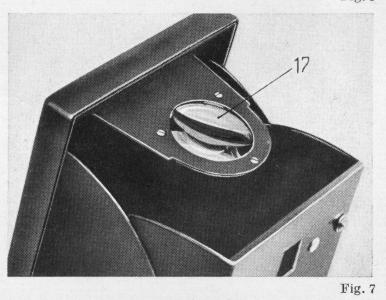
1. Opening and closing the lighthood
To close the light
hood, push the cover down towards the back, and the rear flap will fold in
automatically. The lighthood closes with an audible click. Make sure that the
focusing magnifier (17) has been swung in beforehand.
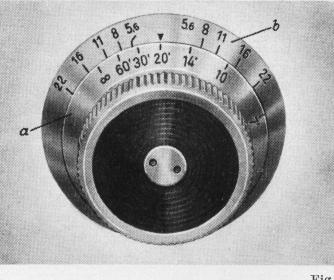
2. Focusing
The image is visible on the ground glass screen and can be
focused at distances between infinity (00) and 1 meter (3' 4") The camera
mechanism guarantees absolutely even sharpness between finder lens (2) and
taking lens (1).
You will find two scales on the focusing knob (9)
a) the rotatable distance scale with figures indicating feet, or meters,
b) the firmly attached depth-of-field scale (8) showing the diaphragm numbers.
The latter are in symmetrical order (Fig. 6).
For critical focusing, you
have the focusing magnifier (17) in the light hood (Fig. 7).
3. How to use the sports finder
The sports
finder in the light hood gives you the choice of focusing either by means of the
ground glass image or in direct-vision.
On opening the light hood you
will, at first, always see the ground glass image.
If you intend using the
sports finder, you have to push in the cover (4) bearing the factory sign until
you hear it click. First make sure that the focusing magnifier is not swung up.
back to its original position (Figs. 8 and 9).
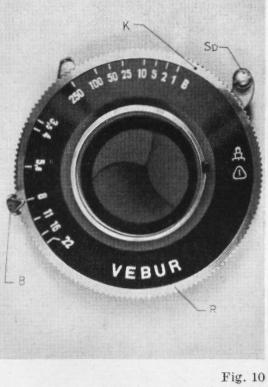
5. Setting the shutter speeds
6.1.
The Vebur Shutter
The Vebur is a between-the-lens shutter with speeds
ranging from 1 sec. to 1/250 sec. and B (any desired length of time) (Fig. 10).
Instant exposures - (meaning the shutter is open
less then a second )
Turn the milled ring (R) until the desired number stands under the (K) mark,
wind up the shutter by pressing the lever (Sp) downwards as far as it will go.
The film is exposed by pressure on the body shutter release (2).
Turn the milled ring (R) until the "B"
stands under the (K) mark and press the lever (Sp) downwards as far as it will
go. Pressure on the body shutter release (20) will open the shutter which closes
again as soon as the release lever is liberated. It is required to use a tripod
and a cable release for time exposures. (most film has estimates on time
exposures on the package)
The Vebur shutter can also be released by
means of any one of the commonly marketed self-releases.
The diaphragm lever (B) is
designed for setting the diaphragm stops between the
largest aperture
f/3.5 and the smallest f/22.
Important: The smaller the diaphragm,
the longer will have to be the exposure. But also: the smaller the diaphragm,
the greater will be the depth o f field (see depth-of-field scale).
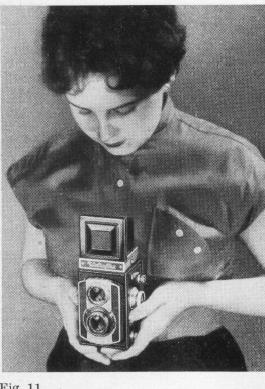
7. Releasing the shutter
The shutter is released, as already described, by pressure on the body shutter
release (20).
You will find it most convenient to release the shutter with
your right thumb, holding the camera firmly between your right and left hands
(Fig. 11) and so protecting it from unsteadiness. You can also make the exposure
by means of a wire release. The connecting piece (3) for the wire release is on
the right-hand upper front of the camera (Fig. 11). To avoid faulty exposures,
always depress the body shutter release as far as it will go.
8. Prevention against double exposures
At the
moment the shutter is being released, the device preventing double exposures
coupled to the shutter starts operating. The shutter cannot be actuated again
before the film has been advanced by rotation of the transport knob and the
shutter-winding lever (Sp) has been wound up. The camera is ready for the next
exposure as soon as the following film number appears in the pan-protection
window (12).
The flash connection (10) is
situated on the left sidewall of the camera and is joined to the shutter by a
cable.
The synchronous flash contact built into the Vebur shutter (X
contact) permits flashlight exposures, also instant shots, with flash bulbs,
flash tubes (electronic flashes) and flash powder.
In the Vebur shutter,
the electric circuit is closed at full opening of the shutter (X contact). This
makes the use of electronic flashes (without delay) possible with all shutter
speeds. Flash bulbs, on the other hand, can be used only with the shutter speeds
named in the chart. The shortest shutter speed for electronic flashes with delay
is '/so sec.
Flash Bulbs
Shutter Speed
Remarks
Osram: AP
RFT: F 19 1/50 sec. or longer
or other flash bulbs
Osram: F 1; F 2; S 1; S 0; X 0
.RFT; F
20; F 32; F 40; DF 40
Philips; Pf 14; Pf 3; Pf 25; Pf 60
USA Bulbs:
Press 25; 40; 50
No. 0; 2 1/25 see' or longer
Osram: S 2
RFT: DF 20; DF 70 N
Philips: Pf 100
USA Bulbs: No. 3; 501/10 sec. or longer
USA: SM and SF
1/100 see. or longer
Time exposures
Turn the milled ring until the (K)
mark stands underneath the B. Again, push the lever (Sp) upwards. The shutter is
opened by pressure on the body shutter release and closes again as soon as the
release lever is liberated (after any desired length of time). We advise using a
tripod and a wire release for time exposures. A tripod socket is built into the
bottom of the camera.
The X and M contacts are set by means of the
transfer lever (U).
X or M exposure is exclusively determined by the
position of the transfer lever (U) as follows:
2. Exposures with flash:
Setting according to chart.
3. Exposures with self-timer: V setting.
When making your preparations for the exposure,
besides winding up the shutter and setting diaphragm stop and shutter speed, you
need only to adjust the transfer lever.
Very important feature: It
does not matter in which sequence you accomplish these performances. Also the
transfer lever may be adjusted either before or after the shutter has been wound
up; this means that you can change its position as often as you wish!
Setting the diaphragm
The desired diaphragm stop is set by
swinging the diaphragm lever (B) on the lower part of the shutter in either
direction.
The smaller the diaphragm stop, the longer will have to be the
exposure.
But also : the smaller the diaphragm stop, the greater will be
the depth of field (see depth-of-field scale).
Strap holders
A
carrying strap can be fastened to the eyelets (6) on the right and left of the
camera body, should you wish to carry the camera without a case.
A few
hints concerning the exposure
1. Do not forget to advance the film after
each exposure !
2. Exposure time and diaphragm stop are closely related.
The more light you take/ away by stopping down to f/8, f/11, or further, the
more you will have to increase the exposure time.
For example: A speed
setting of 1/100 sec. at f/5.6 will give the same result as f/8 and 1/50 sec.,
or f/11 and /25sec. These figures can be continued in either direction as
desired. The only difference will be the depth of field.